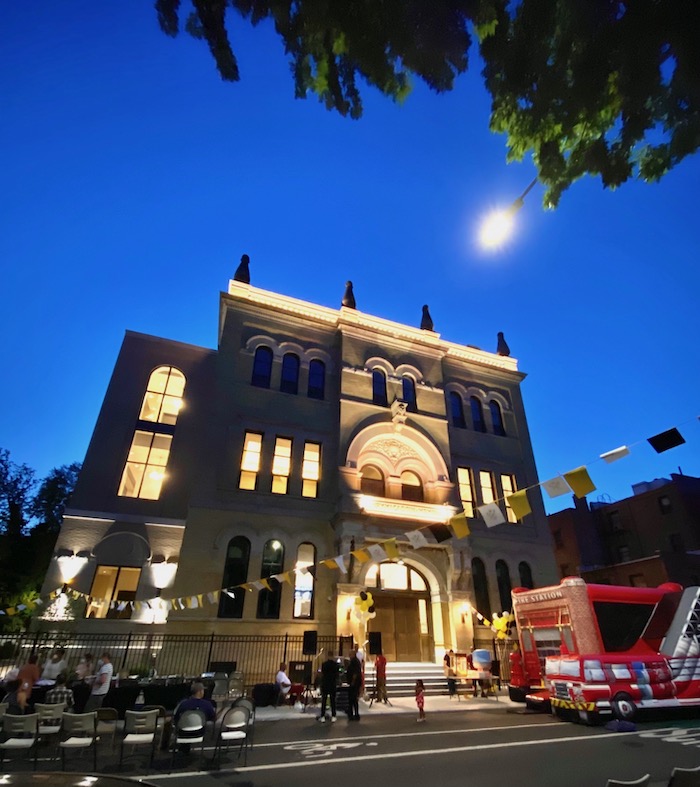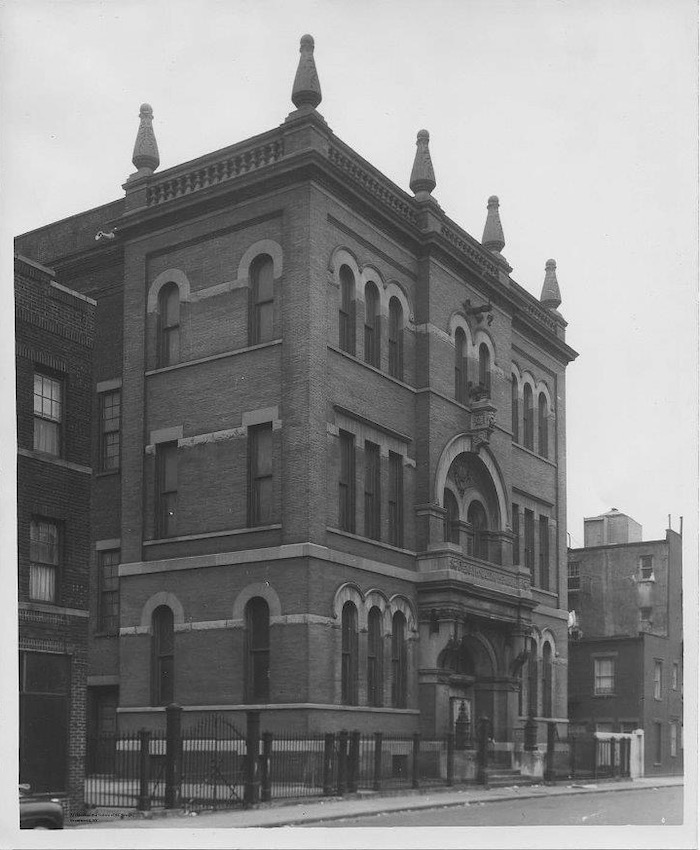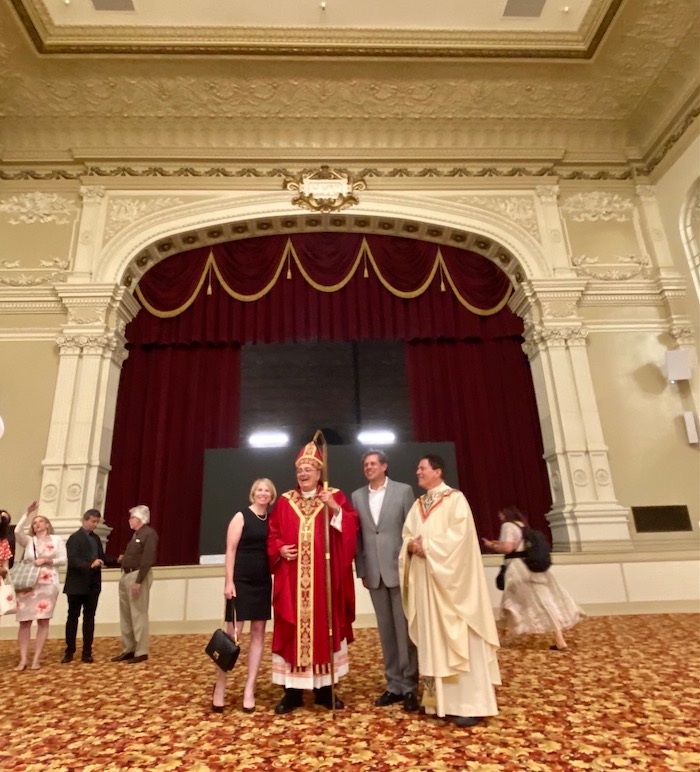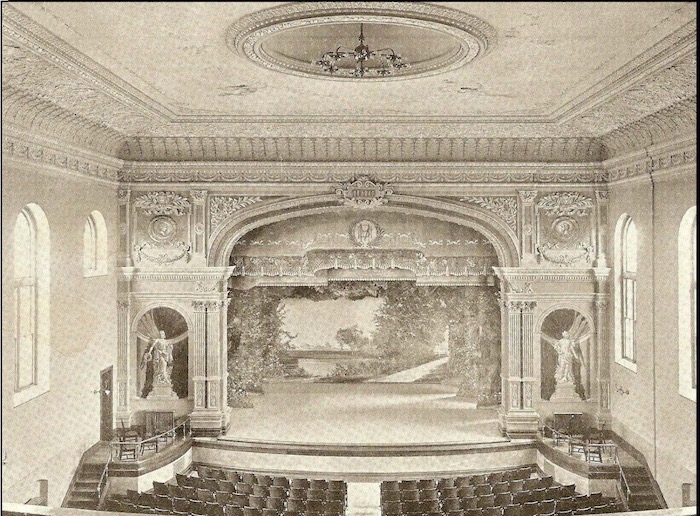By Bill Miller, Senior Reporter
A historic opera house on Brooklyn’s northwest side has been brought back to its former glory to serve as the Diocese of Brooklyn’s own performing arts venue.
The recently renovated Henry McCaddin Memorial building is not just the new home of Saints Peter and Paul-Epiphany Parish. It also houses the new Emmaus Center — the Diocese of Brooklyn’s own performing arts venue. 
The center retains the building’s original second-floor theater and third-floor balcony with seating for up to 700 people.
Bishop Nicholas DiMarzio blessed the new Emmaus Center Tuesday, June 29, after a special Mass to dedicate the new church and consecrate its altar, which is located on the first floor.
Emmaus Center performances — the first possibly this fall — will entertain people of all religions or no faith at all, said Bishop DiMarzio moments before the dedication Mass.
“This community is completely different than it was 10 years ago,” Bishop DiMarzio said of arts oriented Williamsburg. The neighborhood has drawn droves of newcomers during gentrification that began in the 1990s. Bishop DiMarzio noted the people are “from all over the world.”
“And this community center, this Emmaus Center, we’re calling it, will reach out to newcomers,” he said. “Yes, we will invite these young people to prayer, but also to art, music, and the theatre a place of encounter with them.”
GREAT OAKEN DOORS AND GARGOYLES
Although the Emmaus Center is new, the McCaddin building itself is nearly as old as Carnegie Hall, for which ground was broken in 1890.
Seven years later, Father Sylvester Malone, pastor of Saints Peter and Paul Parish, ceremoniously turned the first shovel of dirt for what would become the stout building. It honored the memory of Henry McCaddin Jr., a prominent real estate developer and community supporter.
The McCaddin family belonged to Saints Peter and Paul Parish, which Father Malone pastored from 1844 until he died in 1899. Anna Eliza Walsh, McCaddin’s sister, paid for the multipurpose center at South 3rd and Berry Streets.
The parish produced a souvenir booklet for the building’s dedication ceremony. It stated:
“Today, this 20th day of November, 1898, we are assembled to dedicate this noble structure of the renaissance, the Henry McCaddin Memorial. Its three stories of buff brick and Indiana limestone, especially beautiful in the outline and fine carving of its imposing entrance, its great oaken doors, its lamps, and gargoyle figures, make it a building of which the city may be well proud.”
Historians believe the McCaddin building was one of the first opera halls in Brooklyn.
MOST ENDURING CHARACTER
Brooklyn architect Thomas Houghton, the son-in-law of famed church architect Patrick Keely, designed the McCaddin building. It held the theater and a library. The basement included classrooms, a bowling alley, and a pool.
The inside had ornamental door frames and trim, mosaic tile flooring, cast-iron stair railings, elaborate plaster moldings, and coffered ceilings. 
And it was built like a fort.
According to the booklet: “The beams, columns, posts, and girders are of iron, and the great iron trusses of the roof are covered in brick tile and copper…Such materials go to make a building of the most enduring character.”
Fast forward to the 21st century. Parts of Williamsburg are home to low-income residents. Consequently, Saints Peter and Paul Parish has struggled to be financially independent.
A fire in 1957 forced the demolition of the original Keely-designed church building on nearby Wythe Avenue.
In 1963, the parish occupied a “provisional” chapel on South 2nd Street. In 2007, it merged with Epiphany Church on South 9th Street, but fiscal challenges persisted.
A few years later, Msgr. Anthony Hernandez, then the parish administrator, got an idea while visiting the McCaddin building. It had fallen into disrepair since a school it once housed shut down in 2002, but the monsignor saw potential.
“We knew we had this building that was incredibly well-built,”Msgr. Hernandez said. “It had ‘great bones,’ as they say.”
But it also had historical value for Brooklyn, he said. “So,” he added, “it didn’t make sense to demolish it.”
Then he noticed that the first floor’s length was well suited for long aisles and rows of pews.
“And I thought, ‘Why don’t we just blow out the walls and locate the church on the first floor?’” Msgr. Hernandez recalled. “While they were at it, they could restore the rest of the building,” he said.
But first, the planners had to figure out financing. They settled on a strategy perfected by the historic Trinity Church, an Episcopal parish at the corner of Broadway and Wall Street in the Financial District in lower Manhattan.
With origins that date back to the late 1600s, Trinity has a famous cemetery that is the resting place of Alexander Hamilton, one of the nation’s founding fathers.
Over time, the parish became the owner of downtown real estate assets and an investment portfolio worth an estimated several billion dollars.
Msgr. Hernandez said the parish thus determined to leverage its own property holdings in the old property.
“We called it the Trinity Model,” Msgr. Hernandez said of the financing strategy. “We wanted to do the same, so we decided to ‘land lease’ the parking lot and church.”
Bishop DiMarzio enthusiastically OK’d the plan, and Vatican officials praised its creativity.
A MONUMENTAL TASK
The firm, Tobin Parnes Design, envisioned an extension to the McCaddin building’s south side.
 Now complete, this extra space includes corridors, another staircase, an elevator, more restrooms, improved access for people with disabilities, and a large section of stained-glass windows.
Now complete, this extra space includes corridors, another staircase, an elevator, more restrooms, improved access for people with disabilities, and a large section of stained-glass windows.
Pieces from the old chapel, such as the crucifix and icons, be- came refurbished highlights in the new church’s décor.
Likewise, Tobin Parnes worked to preserve the McCaddin build- ing’s interior, including the large arched doors and floors made of Tennessee marble.
Some features had to be replicated, like the theater’s carpeting and upholstery, said Msgr. Jamie Gigantiello, the diocese’s vicar of development.
“But,” he added, “the railings on each side of the seats — the metal — that’s the original.”
The renovation began in 2016, with a two-year goal to complete it. The work, however, stretched into 2021.
“First of all, construction always takes double the time they tell you,” Msgr. Gigantiello said. “Then we had the pandemic for 18 months, and that led to a shutdown of production, construction, and planning. But I always like to look on the flip side of things.
“I think it’s worth the wait.”
Msgr. Gigantiello said the Emmaus Center gives him more freedom and flexibility for event planning, one of his responsibilities.
“We own it!” he exclaimed. “I don’t have to go to a venue like Carnegie Hall or Lincoln Center. They’re nice, but they’re so much bigger, and you have to go according to their rules. You’re limited. You can’t even hand out flyers, lights, or candles.
“One time when we went to Carnegie Hall, we had flashlights, but we weren’t allowed to hand them out. We had to get someone else, and we had to pay them. Here, this is ours. We can do what we want.
“Through the arts, we can evangelize to this local neighborhood.”
CERTAINLY WORTHY OF GOD
In his dedication Mass homily, Bishop DiMarzio described how the performance center got its name from Luke 24:13-35. In this scene, two disciples on the road to Emmaus grieved the death of their lord, Jesus. Then, a stranger walked up and reminded them how the crucifixion fulfilled a prophecy. 
The disciples then realized the stranger was the risen lord.
The bishop recited, “’Were not our hearts burning within us? Did we not recognize that it was Jesus?’ So, it is with so many people today.
“They are sad. They do not know Christ. They have not encountered Him. But this is what we have to give to the world: our belief in life eternal through the resurrection of Jesus Christ.”
Bishop DiMarzio called the renovation a “monumental task.”
He praised the contributions of Msgr. Hernandez; Executive Director Coleen Ceriello and the staff of Rocklyn Asset Corp.; Father Espinal, the parish’s current administrator; Msgr. Gigantiello; Craig Tubiolo, the center’s new executive director; DeFazio Construction; and Tobin-Parnes Design.
“It is most beautiful,” Bishop DiMarzio said of the completed project, “and certainly worthy of God.”

I played basketball here in the 50’s. Great transformation! Never knew the history of this magnificent building!